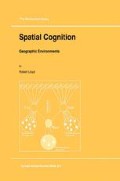Abstract
The complex world we encounter every day contains many objects. We selectively focus attention on some of the objects and may wish to store important information associated with these objects. This information could include where information, recording the object’s location, and what information, recording other characteristics such as the object’s shape, color, or size. Encountered objects vary in their relative importance to the person experiencing the objects (Figure 4.1). Many objects that exist in the environment are completely ignored because we never focus attention on them. Other objects may attract our attention long enough to make us briefly aware of their existence just long enough to decide we have no further interest in them. At times we may be forced to abandoned objects we have focused on as we shift attention to new objects because our working memory has a limited capacity (Baddeley 1986). At other times we may have sufficient interest in an object we are perceiving to track it over time and update any changes to the where and what information associated with it. The location of the object may change while we are experiencing it as well as its other characteristics. Because we have attended to the object and updated information related to it, we know it is the same object. If we wish to store information about the object after perception processes are completed, it would be necessary to encode the information related to the object into long-term memory (Figure 4.1). This could be verbal information expressed as a conceptual-proposition such as the car is blue or the car is in the garage. It could also be a visual image of the blue car in the garage.
Access this chapter
Tax calculation will be finalised at checkout
Purchases are for personal use only
Preview
Unable to display preview. Download preview PDF.
Author information
Authors and Affiliations
Rights and permissions
Copyright information
© 1997 Springer Science+Business Media Dordrecht
About this chapter
Cite this chapter
Lloyd, R. (1997). Storing Spatial Information in Memory. In: Spatial Cognition. GeoJournal Library, vol 39. Springer, Dordrecht. https://doi.org/10.1007/978-94-017-3044-0_4
Download citation
DOI: https://doi.org/10.1007/978-94-017-3044-0_4
Published:
Publisher Name: Springer, Dordrecht
Print ISBN: 978-90-481-4783-0
Online ISBN: 978-94-017-3044-0
eBook Packages: Springer Book Archive

